Physical Address
304 North Cardinal St.
Dorchester Center, MA 02124
Carcinoma of the urinary bladder is the fourth most common malignancy in men, accounting for an estimated 60,490 new cases and 12,240 cancer deaths in the United States in 2018. Significant progress has been made in the diagnosis and treatment of bladder cancer. Bladder cancer is morphologically heterogeneous; more than 90% of bladder cancer cases are urothelial (transitional cell) carcinoma, whereas primary squamous cell carcinoma, adenocarcinoma, small cell carcinoma, and other tumors are less common. The classification system of urinary bladder neoplasia used in this chapter has been modified according to the 2016 World Health Organization (WHO) classification of tumors of the urinary system.
Urothelial papilloma is a benign exophytic urothelial neoplasm that typically occurs in patients younger than 50 years. The male-to-female ratio is 2:1. The most common symptom is hematuria. Most tumors are located near the ureteric orifices. Urothelial papilloma may recur, but recurrent papilloma does not progress.
The diagnostic criteria for urothelial papilloma in the 2016 WHO classification are identical to those defined in the 1973 WHO classification. Using the restrictive diagnostic criteria recommended by the WHO, urothelial papilloma represents less than 1% of papillary urothelial neoplasms. Urothelial papilloma is composed of a delicate fibrovascular core covered by cytologically and architecturally normal urothelium with no more than seven layers of cells ( Fig. 6.1 ). The superficial cells are often prominent and may have vacuolization of the cytoplasm, eosinophilic syncytial or apocrine-like morphology, or may demonstrate mucinous metaplasia. Mitotic figures are absent to rare and, if present, are in the basal cell layer. The stroma may show edema or inflammatory cells. Rare cases show dilated lymphatics within the fibrovascular fronds. Occasionally, foamy histiocytes accumulate within the fibrovascular stalks. Secondary budding of small fronds from larger simple primary papillary fronds is commonly observed.
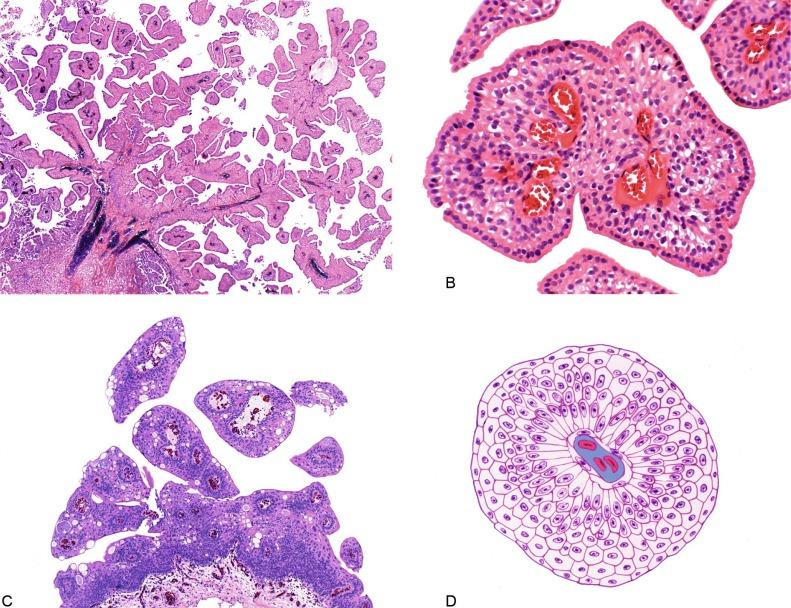
Papilloma is a diploid tumor with a low proliferation rate, undetectable or very limited p53 accumulation, and frequent fibroblast growth factor receptor 3 (FGFR3) mutation (75% of cases). Cytokeratin (CK) 20 expression is limited to the superficial (umbrella) cells. Telomerase reverse transcriptase (TERT) promoter mutations are present in 46% of urothelial papilloma cases.
The designation of diffuse papillomatosis is applicable when the mucosa is extensively involved by multiple small delicate papillary processes, creating a velvety cystoscopic appearance. These papillary structures are covered by normal urothelium with no cytologic atypia ( Fig. 6.2 ). The malignant potential of this lesion is uncertain.
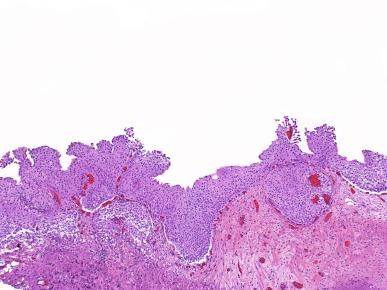
Inverted papilloma is usually found in males in the sixth or seventh decade of life. The male-to-female ratio is 7:1. Hematuria and obstructive symptoms are the most common symptoms at presentation. The majority of inverted papillomas develop in the region of the trigone and bladder neck ( Fig. 6.3 ). Some cases may be multifocal. The incidence of multiplicity ranges from 1.3% to 4.4%. A significant number of patients have a history of smoking, suggesting a possible link between tobacco use and inverted papilloma. Human papillomavirus (HPV) infection is not a causative agent of urothelial inverted papilloma.
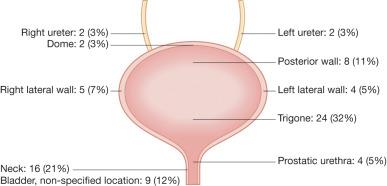
Histologically, inverted papilloma shows an inverted growth pattern, usually composed of anastomosing islands and trabeculae of histologically and cytologically normal urothelial cells invaginating from the surface urothelium into the subjacent lamina propria but not into the muscularis propria ( Fig. 6.4 ). Although the term inverted papilloma was initially introduced in 1963 by Potts and Hirst to describe this architecturally distinctive urothelial neoplasm, the Viennese urologist Paschkis had previously reported four morphologically identical urothelial tumors in 1927 under the name of adenomatoid polyp . Kunze et al. proposed the subdivision of inverted papilloma into two morphologically distinct variants, trabecular and glandular. By their criteria the trabecular variant is composed of anastomosing cords and trabeculae of urothelial cells invaginating the lamina propria at various angles. These invaginating structures demonstrate mature urothelium centrally, with darker and palisading basal cells peripherally, usually surrounded by fibrotic stroma without marked inflammation. The glandular variant is composed of nests of urothelium with either pseudoglandular spaces lined by mature urothelium or even true glandular elements, containing mucicarminophilic secretions and mucous-secreting cells. The glandular variant, as proposed by these investigators, has considerable morphologic overlap with florid cystitis glandularis and is not widely accepted as a diagnostic entity.

Within the spectrum of findings in inverted papilloma, vacuolization and foamy xanthomatous cytoplasmic changes may be seen. These “clear cells” may be concentrated within distinct regions of the tumor, but more frequently are diffusely intermingled with usual inverted papilloma cells. Foci of nonkeratinizing squamous metaplasia and neuroendocrine differentiation have been reported. Mitotic figures are either absent or rare. Some cases may demonstrate focal minor cytologic atypia that is likely degenerative in nature and has no clinical significance. Inverted papilloma may coexist with carcinoma, and it is most important to differentiate inverted papilloma from urothelial carcinoma with inverted growth pattern. Such distinction may be difficult, especially in limited biopsy specimens or when interpretation is confounded by crush artifact. Inverted papilloma usually exhibits orderly maturation of invaginated trabeculae and cords, composed of spindling and peripherally palisading cells. In contrast, urothelial carcinoma with an inverted growth pattern often has thick and irregular tumor columns with transition to more solid nests. In addition, the presence of an exophytic papillary component and unequivocal tumor invasion in the lamina propria or muscularis propria justifies a diagnosis of inverted urothelial carcinoma. Marked cytologic atypia, including nuclear pleomorphism, nucleolar prominence, and abundant mitotic activity, further supports a diagnosis of malignancy.
Several investigators have voiced concern regarding the malignant potential of inverted papilloma based on the subsequent development of urothelial carcinoma, but most patients with this complication have a history of a prior or concurrent urothelial carcinoma. In a large series of 75 patients, all but 1 patient had an uneventful course without either tumor recurrence or progression to urothelial malignancy during a mean follow-up of 68 months. Consequently, transurethral resection of inverted papilloma is adequate treatment, and surveillance protocols as rigorous as those used in the management of urothelial carcinoma seem unnecessary for this benign entity.
It has been well documented by the finding of nonrandom inactivation of X chromosomes that inverted papilloma is a clonal neoplasm that arises from a single progenitor cell. Sung and colleagues studied the status of loss of heterozygosity (LOH) in inverted papilloma using microsatellite markers that are commonly altered in urothelial carcinoma. The incidence rate of LOH in inverted papilloma is low (8% to 10%) and contrasts with the high frequency of LOH (29% to 80%) in urothelial carcinoma and papillary urothelial neoplasm of low malignant potential (PUNLMP). The low frequency of allelic loss in inverted papilloma is similar to that of normal urothelium. Lott and et al. evaluated mutations of FGFR3 and TP53 genes by DNA sequencing in 20 cases of inverted papilloma of the urinary tract. Point mutations of the FGFR3 gene were identified in 45% (9/20) of inverted papillomas, with four cases exhibiting mutations at multiple exons. Seven cases had exon 7 mutations of the FGFR3 gene, containing R248C, S249T, L259L, P260P, and V266M. Two cases had exon 10 and 15 mutations, including A366D, H412H, E627D, D641N, and H643D; five cases had N653H. The most frequent mutation of the FGFR3 gene was identified at R248C. None of the inverted papillomas exhibited mutations in TP53.
Telomere shortening using fluorescence in situ hybridization (FISH) analysis is seen in about 70% of urothelial carcinomas with inverted growth, but in only 9% of inverted papillomas. Telomere FISH analysis is useful to separate these two entities in selected challenging cases. A recent TERT promoter mutation status study reported 15% mutation in inverted papilloma compared with 58% in urothelial carcinoma with inverted growth, suggesting that there is a subpopulation of inverted papilloma that shares a carcinogenetic pathway with urothelial carcinoma with inverted growth and conventional urothelial carcinomas.
The markedly reduced frequency of LOH, the absence of TP53 mutations, the absence of telomere shortening, and the pattern of FGFR3 mutations in inverted papilloma compared with that of urothelial carcinoma suggest that inverted papilloma does not harbor the key genetic abnormalities that predispose to the development of urothelial carcinoma and may indicate that these entities arise through separate and distinct pathogenetic mechanisms.
Squamous papilloma is a rare benign neoplasm; it may represent the squamous counterpart of urothelial papilloma. It is unrelated to HPV infection, usually occurs in elderly women, and follows a benign clinical course. Histologically, it is composed of papillary cores with overlying benign squamous epithelium ( Fig. 6.5 ). These tumors are diploid with undetectable or very limited nuclear p53 accumulation. Some demonstrate immunohistochemical expression of epidermal growth factor receptor (EGFR) protein.
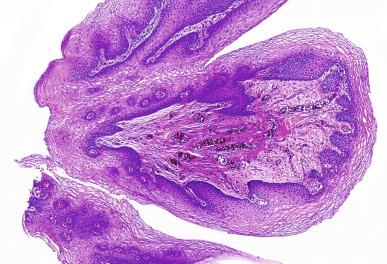
In the 2016 WHO classification of tumors of the urinary tract, the term urothelial proliferation of uncertain malignant potential (UPUMP) was recommended for lesions previously known as papillary urothelial hyperplasia and flat urothelial hyperplasia. It also recognized that some may actually represent a “shoulder” lesion of previously resected urothelial papillary tumor.
UPUMP typically occurs in patients with either a prior or concurrent low-grade papillary urothelial neoplasia. Most patients are men with a mean age of 67 years. These lesions are characterized by undulating folds of urothelium that lack cytologic atypia and fibrovascular cores ( Fig. 6.6 ). Cytologically, the cells in UPUMP lack atypia and maintain nuclear polarity. There may be increased vascularity in the stroma at the base of the papillary folds.
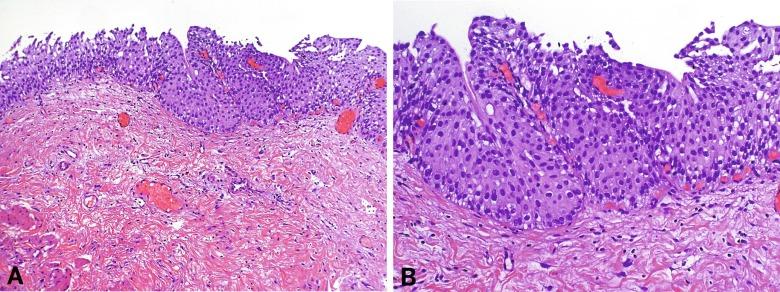
Recent data suggest that papillary hyperplasia may be a precursor to low-grade papillary neoplasms. These lesions may also evolve into a high-grade noninvasive (Ta) papillary urothelial carcinoma. Swierczynski and Epstein reported 15 cases of papillary urothelial hyperplasia with varying degrees of atypia ranging from dysplasia to flat carcinoma in situ (atypical papillary urothelial hyperplasia). On follow-up examination, most of these patients had experienced high-grade urothelial neoplasms. These cases may be viewed as urothelial carcinoma in situ or dysplasia with early papillary formation.
The term urothelial proliferation of uncertain malignant potential (UPUMP), recently introduced in the 2016 WHO classification of urinary tract tumors, is meant to include flat urothelial hyperplasia in addition to papillary hyperplasia (see earlier discussion), but in practice we recommend that the term flat urothelial hyperplasia be used.
Normal urothelium is a multilayered epithelium composed of basal, intermediate, and superficial cells ( Fig. 6.7 ). The number of cell layers (usually less than seven) may vary because of tangential sectioning. Urothelial hyperplasia is characterized by markedly thickened mucosa with an increase in the number of cell layers, usually ≥ 10 ( Fig. 6.8 ). However, it is not necessary to count the number of cell layers for the diagnosis. The cells in urothelial hyperplasia do not show any significant cytologic abnormalities, although slight nuclear enlargement may be focally present. Morphologic evidence of maturation from base to surface is generally evident. Urothelial compression artifact or tangential sectioning of mucosa with pseudopapillary growth (lacking a true vascular core) may resemble flat urothelial hyperplasia.
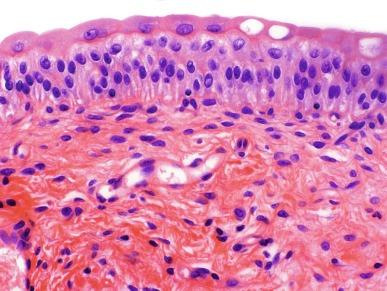
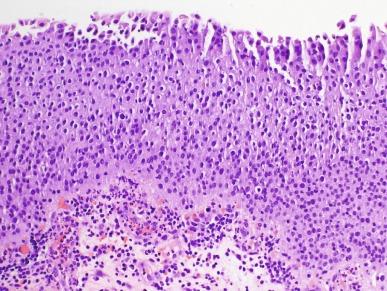
Flat urothelial hyperplasia has been observed in association with a variety of conditions including inflammatory disorders, urolithiasis, papillary urothelial hyperplasia, dysplasia, carcinoma in situ, and low-grade papillary tumors. When seen as an isolated phenomenon, there is no evidence to suggest that primary urothelial hyperplasia has a premalignant potential. However, molecular analyses showing chromosome 9q deletions and mutations in the FGFR3 gene in both urothelial hyperplasia and low-grade papillary neoplasia suggest that this lesion may be clonally related to the papillary tumors in patients with bladder cancer. Flat urothelial hyperplasia has been considered by some authors to be the source of papillary neoplasia, usually associated with low-grade tumors.
The classification of nonpapillary (flat) intraepithelial lesions and conditions of the urothelium has evolved over the years and was redefined at the International Consultation on the Diagnosis of Noninvasive Urothelial Neoplasms held in Ancona (Italy, 2001) ( Table 6.1 ) . This classification includes epithelial abnormalities (reactive urothelial atypia and flat urothelial hyperplasia), presumed preneoplastic lesions and conditions (keratinizing squamous and glandular metaplasia and malignancy-associated cellular changes), as well as preneoplastic (dysplasia) and neoplastic noninvasive (carcinoma in situ) lesions ( Fig. 6.9 ). Each of these lesions is defined with strict morphologic criteria to provide more accurate information to urologists in managing patients ( Table 6.2 ).
Flat urothelial hyperplasia
Reactive urothelial atypia
Presumed preneoplastic lesions and conditions
Keratinizing squamous metaplasia
Intestinal metaplasia
Malignancy-associated cellular changes
Preneoplastic lesions
Dysplasia
Neoplastic noninvasive lesion
Urothelial carcinoma in situ
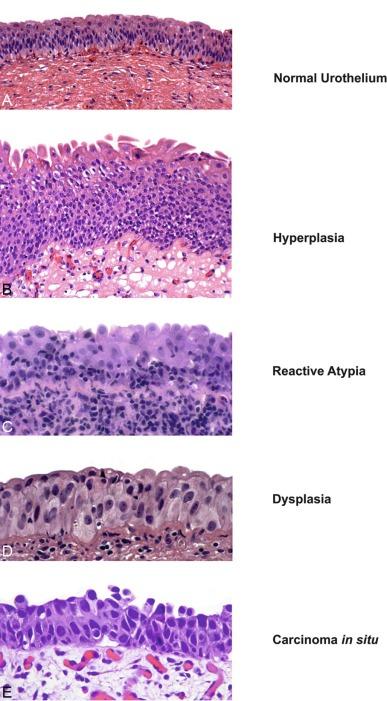
| Features | Reactive Atypia | Hyperplasia | Dysplasia | Carcinoma In Situ |
|---|---|---|---|---|
| Cell layers | Variable | > 7 cells | Variable | Variable |
| Polarization | Slightly abnormal | Normal | Slightly abnormal | Abnormal |
| Cytoplasm | Vacuolated | Homogeneous | Homogeneous | Homogeneous |
| Nuclear-to-cytoplasmic ratio | Normal or slightly increased | Normal or slightly increased | Slightly increased | Increased |
| Nuclei | ||||
| Anisonucleosis | Normal | Normal | Mild | Moderate to severe |
| Borders | Regular/smooth | Regular/smooth | Notches/creases | Pleomorphic |
| Chromatin | Fine/dusty | Fine | Slight hyperchromasia | Coarse/hyperchromatic |
| Chromatin distribution | Even | Even | Even | Uneven |
| Nucleoli | Large | Small/absent | Small/absent | Large/prominent |
| Mitotic figures | Variable | Absent | Rare | Often |
| Denudation | Variable | No | No | Variable |
| CK20 | Surface | Surface | Variable | Variable |
| Stromal microvascular proliferation | Variable | Variable | Less prominent | Often prominent |
Great advances have been made in the molecular genetic and biomarker characterization of bladder cancer in recent years. Malignancy-associated cellular change is a recently introduced concept, encompassing urothelial abnormalities in bladders harboring neoplasia that are not evident by routine light microscopy but are demonstrable by chromatin analysis or genetic studies. The clinical relevance of malignancy-associated cellular changes remains to be established, but these parameters may be important in evaluating the status of residual urothelium after surgical bladder tumor resections. Recent studies have shown that 50% of the histologically normal urothelium adjacent to superficial urothelial carcinoma harbors genetic anomalies on chromosome 9, similar to the anomalies found in the coexisting carcinoma. In addition, nondiploid nuclear DNA histograms occur in 4% to 54% of histologically normal urothelium adjacent to bladder tumors. These genetic alterations suggest a neoplastic potential for flat urothelial lesions, regardless of whether cytologic atypia is present.
Urothelial abnormalities whose architectural and cytologic changes are of lesser degree than those of dysplasia have often been termed atypia . The term atypia is, by its very nature, nonspecific. The intraobserver and interobserver variations in recognition and interpretation of urothelial atypia are substantial. Nevertheless, the term atypia is still in use at many institutions. Two similar categories of atypia have been recently recognized, namely reactive atypia and atypia of unknown significance. Both of them are placed among the “benign” urothelial abnormalities.
Reactive atypia is characterized by mild nuclear abnormalities occurring in acutely or chronically inflamed urothelium. In most cases there is a history of cystitis, instrumentation, infection, stones, or previous therapy. The epithelium may or may not be thickened in reactive atypia. The cells are often larger than normal, with more abundant cytoplasm than normal urothelial cells ( Fig. 6.10 ). These features occasionally impart a squamoid appearance. Nuclei are uniformly enlarged, vesicular, and may have prominent, usually centrally located nucleoli. Mitotic figures may be frequent but always occur in the lower epithelial layers ( Table 6.2 ). Inflammatory cells occupying the lamina propria and infiltrating into the urothelium are invariably present. CK20, CD44, p53, and p16 immunohistochemical stains may be particularly useful from a differential diagnosis perspective ( Table 6.3 ) (see Urothelial Dysplasia section).
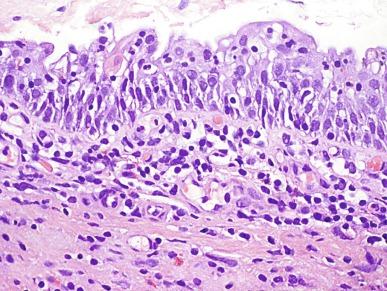
| Conditions | CK20 | CD44 | p53 | p16 |
|---|---|---|---|---|
| Normal | Limited to umbrella cells | Limited to basal cells | Often negative | Absent |
| Flat urothelial hyperplasia | Limited to umbrella cells | Limited to basal cells | May be positive | Unknown |
| Reactive atypia | Limited to umbrella cells | Increased reactivity in all cell layers | May be positive | Absent |
| Atypia of unknown significance | Limited to umbrella cells | Increased reactivity in all cell layers | May be positive | Unknown |
| Dysplasia | Deep layers | Absent | Often positive | Often positive |
| Urothelial carcinoma in situ | Full-thickness expression | Absent | Positive | Positive |
The term atypia of unknown significance was introduced by the International Society of Urological Pathology (ISUP) consensus group to describe lesions in which the pathologist was uncertain whether the changes were reactive or preneoplastic. Atypia of unknown significance is characterized by nuclear changes similar to those seen in reactive atypia. However, the degree of nuclear pleomorphism and hyperchromasia is greater than in reactive atypia, and dysplasia cannot be ruled out. Inflammation in the lamina propria with urothelial infiltration is often present. However, the cellular changes seem to be disproportionate to the degree of inflammation. Atypia of unknown significance is often seen in patients with a previous diagnosis of urothelial neoplasia. Progression to urothelial carcinoma has not been documented. No evidence currently supports a premalignant nature of such lesions. The clinical outcome of patients with atypia of unknown significance is identical to that of patients with reactive atypia. The utility of creating this diagnostic category has been questioned, and the use of the designation “atypia of unknown significance” is discouraged.
Antineoplastic agents used in the bladder or systemically, such as thiotepa (triethylenethiophosphoramide), mitomycin C, cyclophosphamide, bacillus Calmette–Guérin (BCG), and radiation therapy, produce urothelial changes that can mimic cancer histologically. Pathologists must be aware of the diagnostic pitfalls and exercise caution when evaluating urothelial atypia after treatment with chemotherapy or irradiation. In most cases, knowledge of the prior treatment is crucial to correctly diagnosing the epithelial and stromal changes present. If the distinction between treatment-induced atypia and dysplasia/carcinoma in situ is uncertain, a conservative approach with repeat cystoscopy and biopsy is indicated, preferably after the inflammation has subsided.
Cyclophosphamide therapy may induce stromal fibrosis, vascular intimal thickening, mural fibrin deposition in vessels, and vascular ectasia. It also induces epithelial necrosis followed by rapid atypical regeneration. Treatment-induced urothelial atypia may mimic dysplasia or carcinoma in situ ( Fig. 6.11 ). The metabolic effects of cyclophosphamide including arrest of cell and nuclear division produce binucleated and multinucleated cells, often with large, bizarre nuclei resembling radiation injury changes that can be mistaken for malignancy. Cyclophosphamide may also induce reactivation of polyomavirus infection (BK virus), causing marked nuclear atypia in the surface urothelium. In rare cases, BK virus infection mimics flat intraepithelial lesions in immunocompromised patients.
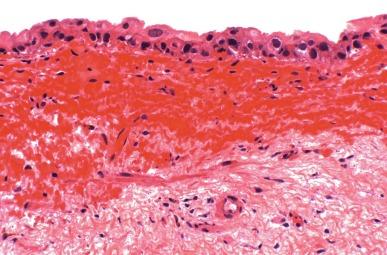
In BCG-treated bladders, it is important to keep in mind that residual carcinoma in situ might only be present in von Brunn nests. Loss of intercellular cohesion in carcinoma in situ may result in the so-called denuding cystitis or in residual neoplastic cells loosely attached to the surface (“clinging” pattern). Also of importance are the reactive changes associated with BCG therapy, which include both acute and chronic inflammation. There may also be a pattern of reactive epithelial atypia and granulomatous reaction deep in the bladder wall.
Mitomycin C and thiotepa, when used as topical chemotherapeutic agents in the bladder, produce identical histologic changes. These include exfoliation, epithelial denudation, multinucleation, cytoplasmic vacuolization, and the appearance of bizarre, nonmalignant nuclei in the superficial layer of the urothelium. A marked necroinflammatory process follows administration of topical mitomycin C. There is a histiocytic response extending deep into the bladder wall. Mitomycin C may also initiate eosinophilic cystitis, a useful clue for the surgical pathologist when evaluating small bladder biopsies in this setting. These agents are not metabolic inhibitors of DNA replication, and thus do not produce full-thickness urothelial atypia, as is seen after cyclophosphamide therapy. Patients receiving ketamine may present reactive urothelial changes that can mimic urothelial carcinoma in situ.
Radiation therapy produces a variety of bladder lesions associated with a progression of pathologic findings. The earliest change, usually seen after 3 to 6 weeks, consists of acute cystitis with desquamation of urothelial cells and hyperemia with edema of the lamina propria. The urothelium shows varying degrees of atypia, including cytoplasmic and nuclear vacuolization, karyorrhexis, stromal hyalinization, thrombosis of blood vessels, and mesenchymal cell atypia similar to that seen in giant cell cystitis. Enlarged nuclei may have large nucleoli, but degenerative nuclear features are usually present. Surface ulceration with fibrin deposition, or a reactive, tumor-like epithelial proliferation associated with fibrosis of the lamina propria or muscularis propria, arteriolar mural thickening and hyalinization, and atypical and sometimes multinucleated stromal cells are features seen in late cases of radiation cystitis, usually becoming evident months or years after radiation therapy. An important long-term effect of radiotherapy is the development of de novo radiation-induced bladder cancer, which usually is a urothelial carcinoma but occasionally is a squamous cell neoplasm. Rare examples of sarcomatoid carcinoma (or carcinosarcoma) and sarcoma of the urinary bladder have been reported.
Several inflammatory conditions of the urinary bladder, some related to treatment, may cause urothelial atypia leading to overdiagnosis of dysplasia and carcinoma in situ. In addition, the damaged mucosa may become ulcerated, with adjacent atypical regenerating urothelium showing pseudocarcinomatous hyperplasia ( Fig. 6.12 ). This change is more common after ulceration related to radiation therapy.
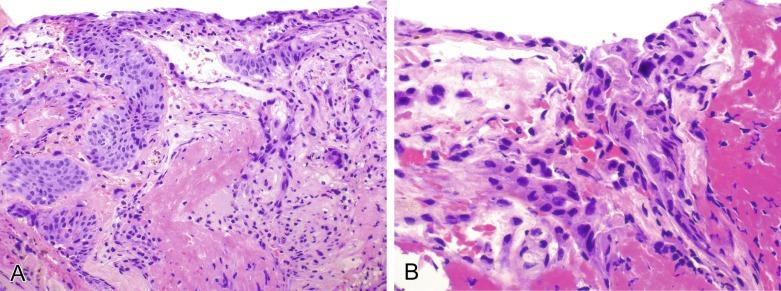
Urothelial dysplasia is defined as abnormal urothelium with cytologic and architectural changes that do not meet all the criteria for an unequivocal diagnosis of urothelial carcinoma in situ ( Fig. 6.13 ). The overall appearance is that of the urothelium in low-grade papillary urothelial carcinoma. The cytologic abnormalities in urothelial dysplasia, characterized by cellular crowding, loss of orderly maturation, and loss of cellular polarity, are not present in the full thickness of the urothelium ( Fig. 6.14 ). Occasionally there may be an increased number of cell layers. The superficial umbrella cells are usually present. Most cellular abnormalities in dysplasia are restricted to the basal and intermediate cell layers. Individual dysplastic cells show enlarged nuclei and nucleoli with irregular contours and coarsening of the chromatin. Multiple nucleoli and nuclear overlapping may be seen. The cells often show cytoplasmic clearing. Mitotic figures, when present, are generally basally located. The transition from normal to abnormal urothelium is subtle, and nondysplastic urothelial cells are often dispersed among the dysplastic cells.
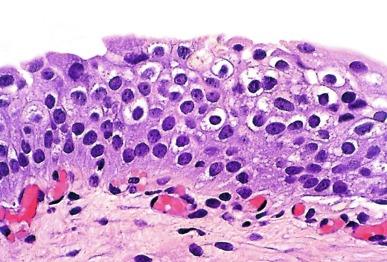
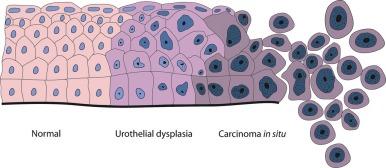
The diagnosis of urothelial dysplasia can be made in cases in which the urothelium demonstrates significant cytologic atypia that cannot be attributed to inflammation or a reparative process and yet lacks the full complement of cytologic abnormalities that characterize carcinoma in situ ( Fig. 6.15 ). Nuclear and architectural features are the primary criteria for distinguishing dysplasia from reactive atypia and urothelial carcinoma in situ. Aberrant CK20 expression in urothelial cells plus overexpression of p53 and Ki67 are indicators of dysplastic change in urothelial mucosa ( Table 6.3 ). Molecular markers may be helpful in the differential diagnosis. CK20 immunostaining is limited to the superficial cell layers in normal urothelium; in contrast, it is usually present in the superficial and intermediate cell layers of dysplastic urothelium. CD44 may be of particular value in the distinction between urothelial dysplasia and reactive atypia. Positive CD44 immunostaining is observed only in the basal cells in normal urothelium and is either absent entirely or present only in scattered cells in urothelial dysplasia, whereas full-thickness positive membranous CD44 staining is typical of reactive urothelium. Dysplastic cells show increased p53 expression, whereas p53 nuclear accumulation is predominantly undetectable or only weakly evident in the basal and parabasal cells in reactive urothelium. Alterations of p53 and allelic losses, particularly in chromosome 9, may occur in dysplasia. p16 has been reported as variably positive in urothelial dysplasia and negative to weak or patchy in reactive urothelium.
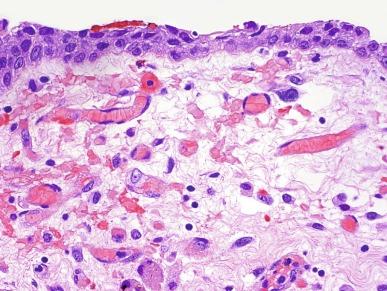
It has proven difficult to create standardized nomenclature for intraurothelial cytologic abnormalities. Consequently, grading of urothelial dysplasia is not currently recommended. The use of the term atypia as a synonym for urothelial dysplasia is discouraged. Intraurothelial cytologic abnormalities that cannot be attributed to a reactive or reparative process and yet lack sufficient abnormalities to be diagnosed as carcinoma in situ should be diagnosed as urothelial dysplasia without qualifiers.
Primary dysplasia occurs in the absence of other urothelial tumors. Its prevalence in the general population is unknown due to lack of large-scale screening studies. In an autopsy series of 313 patients without gross lesions, urothelial dysplasia was present in 6.8% of males and 5.7% of females. Only a few studies provide clinical information on patients with primary dysplasia. These patients are predominantly middle-aged men with irritative symptoms with or without hematuria. The lesion has a predilection for posterior wall location. Dysplasia is not cystoscopically visible, although occasionally the urothelium may appear raised and irregular or mildly erythematous. It is estimated that de novo (primary) dysplasia progresses to bladder neoplasia in 14% to 19% of cases. Using modern criteria for urothelial dysplasia, Cheng et al. found a 19% progression rate in 36 patients with isolated urothelial dysplasia during a mean follow-up of 8.2 years. A similar progression rate (15%) was found in a different cohort of patients.
Secondary dysplasia is seen in patients with a history of bladder neoplasia. The incidence of dysplasia in patients with established bladder neoplasia varies from 22% to 86% and approaches 100% in patients with invasive carcinoma. As many as 24% of random biopsies from patients with stage Ta and T1 carcinomas show epithelial abnormalities that include dysplasia and carcinoma in situ. The presence of urothelial dysplasia indicates urothelial instability and is a harbinger of recurrence and progression. Recurrence rate was 73% of patients with superficial neoplasia and concomitant dysplasia compared with 43% without coexisting dysplasia. Of the 30% of patients with superficial urothelial carcinoma who experienced muscle invasive cancer within 5 years after the initial diagnosis, most had dysplasia or carcinoma in situ adjacent to the primary tumor. Of the patients with dysplasia elsewhere in the bladder mucosa, 36% eventually had muscle-invasive tumors, whereas only 7% of patients with normal urothelium in adjacent biopsies subsequently had muscle-invasive cancer.
Urothelial carcinoma in situ is a flat, noninvasive lesion in which the urothelium is entirely composed of cytologically malignant cells. Melamed et al. first described the natural history of urothelial carcinoma in situ and found that 9 of 25 patients (36%) experienced development of invasive carcinoma within 5 years after the initial diagnosis. In Cheng et al.’s study of 138 patients with urothelial carcinoma in situ in the absence of invasive cancer, the ages at diagnosis ranged from 32 to 90 years (mean, 66 years). The male-to-female ratio in patients with carcinoma in situ is approximately 7:1. Clinical presentations include gross and microscopic hematuria, irritative symptoms (dysuria, pain, frequency), nocturia, and sterile pyuria. Approximately 25% of patients are asymptomatic. Carcinoma in situ usually is multifocal, with a predilection for the trigone, lateral wall, and dome of the bladder. Cystoscopically, it may appear as erythematous velvety or granular patches, although it may also be visually undetectable. Erythematous changes are often apparent at gross examination ( Fig. 6.16 ).
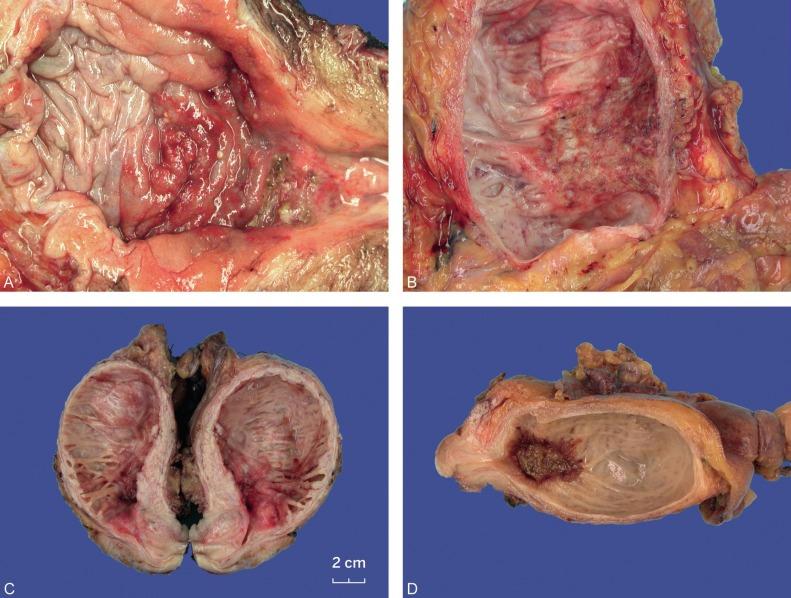
De novo or isolated carcinoma in situ (often referred to as primary carcinoma in situ) accounts for 1% to 3% of bladder neoplasms. Clinical presentation often closely mimics that of interstitial cystitis. Urothelial carcinoma in situ is often multifocal. Mapping studies of cystectomy specimens show extensive carcinoma in situ, with involvement of the prostatic urethra and the ureter in as many as 67% and 57% of cases, respectively. Urothelial carcinoma in situ has a high likelihood of progressing to invasive carcinoma if left untreated. The mean interval between a diagnosis of carcinoma in situ and the detection of cancer progression is 5 years. The actuarial progression-free survival, cancer-specific survival, and all-cause survival rates are 63%, 79%, and 55%, respectively, at 10 years and 59%, 74%, and 40%, respectively, at 15 years ( Fig. 6.17 ). Factors predictive of progression include multifocality, coexistent bladder neoplasia, DNA aneuploidy, CCND3 gene amplification, prostatic urethral involvement, and recurrence after treatment.
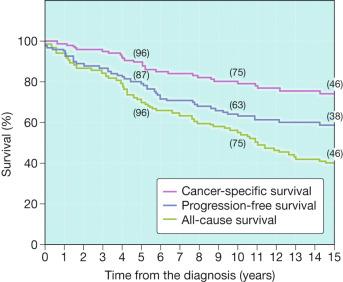
Urothelial carcinoma in situ is often associated with invasive carcinoma elsewhere in the bladder (referred to as secondary carcinoma in situ ). The frequency of carcinoma in situ increases with the grade and stage of the associated urothelial neoplasm. Patients with coexisting invasive urothelial carcinoma have a greater risk for cancer progression and cancer-specific death than patients with primary carcinoma in situ.
Urothelial carcinoma in situ is characterized by flat, disordered proliferation of urothelial cells with marked cytologic abnormalities ( Fig. 6.18 ). The morphologic diagnosis of carcinoma in situ requires severe cytologic atypia (anaplasia). Full-thickness change is not required, which may range from one cell layer to the thickness of hyperplasia (greater than seven cells). Superficial (umbrella) cells may or may not be present. Marked disorganization of cells is characteristic, with loss of cellular polarity and decreased cellular cohesiveness. The tumor cells tend to be large and pleomorphic, with moderate to abundant cytoplasm. Nevertheless, the cells of carcinoma in situ are sometimes small with a high nuclear-to-cytoplasmic ratio. The chromatin tends to be coarse and clumped. Nucleoli may be multiple, and they are large and prominent in at least some of the cells. Mitotic figures, which are often atypical, are seen in the uppermost layers of the urothelium. The adjacent mucosa often contains lesser degrees of cytologic abnormality. Tissue edema, vascular ectasia, and proliferation of small capillaries are frequently observed in the lamina propria ( Fig. 6.18 ).
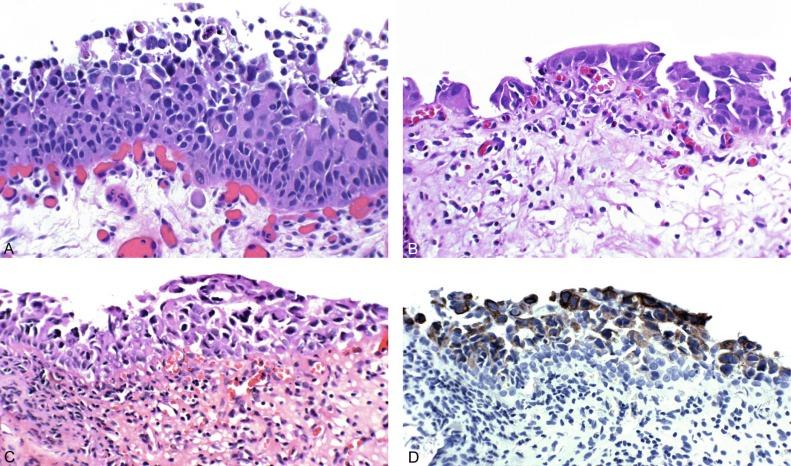
An immunohistochemical panel, consisting of CK20, CD44, p53, and Ki67, may be helpful in differential diagnosis. Carcinoma in situ shows intense CK20 and p53 positivity in most malignant cells. Increased Ki67 labeling is noted in carcinoma in situ, but this can be seen also in reactive atypia of the urothelium, thus limiting its usefulness in practice. The neoplastic cells are uniformly negative for CD44 immunostaining. In contrast, CK20 staining shows patchy cytoplasmic immunoreactivity only in the superficial umbrella cell layer, and CD44 stains only the basal cells in the adjacent normal urothelium. p16 and racemase have been reported as variably positive in urothelial carcinoma in situ and negative to weak and focal in reactive urothelium.
Several morphologic variants and growth patterns of carcinoma in situ have been recognized over the years ( Figs. 6.19 to 6.21 ; Table 6.4 ). Variations in subtype of urothelial carcinoma in situ do not alter patient prognosis. Although it is not necessary to mention these specific growth patterns or morphologic variants in the surgical pathology report, awareness of the histologic diversity of carcinoma in situ may aid in the diagnosis of this therapeutically and biologically important lesion. These lesions may be associated with microinvasion, sometimes clinically unsuspected and histologically subtle.
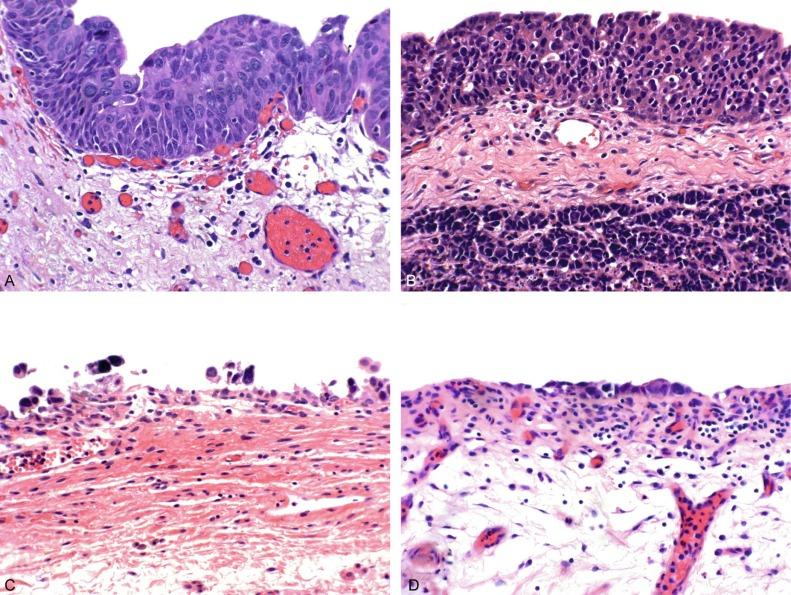
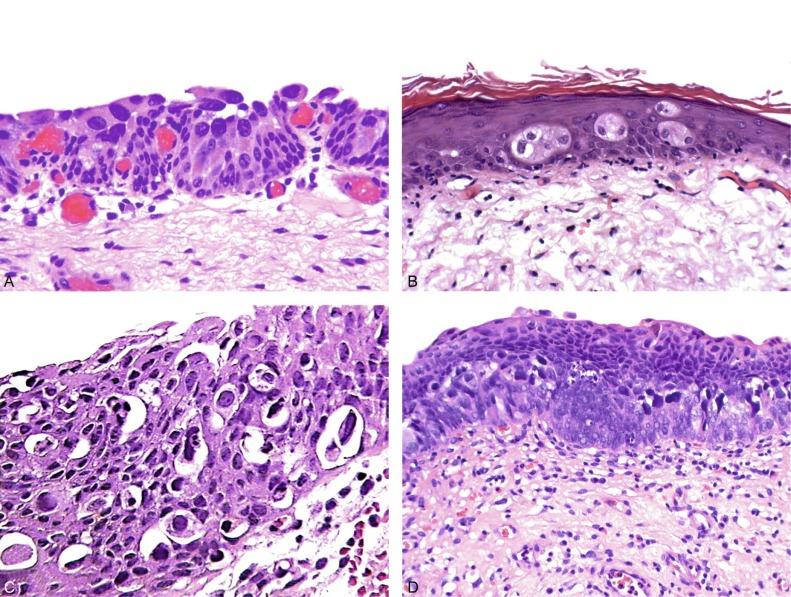
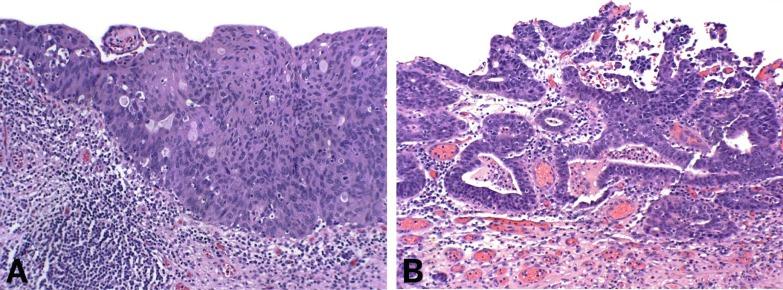
Large cell carcinoma in situ
Small cell carcinoma in situ
Denuding and “clinging pattern” carcinoma in situ
Pagetoid and undermining (lepidic) carcinoma in situ
Carcinoma in situ with squamous or glandular differentiation
Carcinoma in situ with microinvasion
Carcinoma in situ with micropapillary pattern
Large cell carcinoma in situ constitutes the most common morphologic form of this entity. Cytologic findings include nuclear pleomorphism, variably abundant cytoplasm, and anaplastic nuclear features ( Fig. 6.19 A). In rare cases large cell carcinoma in situ may have minor nuclear pleomorphism but still exhibit architectural disarray. Rare cases may focally exhibit high pleomorphism with bizarre giant cells.
The small cell pattern refers to the size of the cells and may or may not coexist with small cell carcinoma ( Fig. 6.19 B); it is unrelated to neuroendocrine differentiation of carcinoma in situ. In such cases the pleomorphism is usually minimal, the cytoplasm is scant, and the nuclei are enlarged and hyperchromatic, with coarse unevenly distributed chromatin. The scattered prominent nucleoli are distorted and angulated. Recognition of the small cell pattern of carcinoma in situ is important to avoid misdiagnosis of basal cell hyperplasia, which has been observed in patients treated with BCG, and show a small cell pattern but lack nuclear atypia or loss of polarity.
In some cases the neoplastic urothelial cells are strikingly discohesive and undergo extensive exfoliation, with the result that biopsies may show only a few residual carcinoma cells on the surface (“clinging carcinoma in situ”) or no recognizable epithelial cells on the surface, a condition referred to as “denuding cystitis” ( Fig. 6.19 C and D). In the clinging pattern of carcinoma in situ, there is a patchy, usually single layer of atypical cells. In mucosal biopsies entirely lacking surface epithelium, carcinoma in situ may be present only in von Brunn nests. A careful search for carcinoma in situ in deeper sections or in other submitted biopsy fragments is important, and a recommendation for evaluation of urine cytology for carcinoma cells is warranted.
Another pattern of carcinoma in situ, also referred to as cancerization of the urothelium, shows either pagetoid spread (clusters or isolated single cells) ( Fig. 6.20 A to C) or undermining or overriding of the normal urothelium (lepidic growth) ( Fig. 6.20 D). Carcinoma in situ exhibiting pagetoid growth is characterized by large single cells or small clusters of cells within otherwise normal urothelium of ureter, urethra, prostatic ducts, or in areas of squamous metaplasia. Individual cells showing pagetoid spread have enlarged nuclei with coarse chromatin; frequently the cytoplasm is clear.
Pagetoid growth patterns can be found in up to 15% of carcinoma in situ cases. Most patients are male and their ages range from 31 to 78 years (mean, 64 years). Pagetoid carcinoma in situ is usually a focal lesion and is easily overlooked. It occurs in a clinical and histologic setting of conventional carcinoma in situ with coexisting invasive urothelial carcinoma, and such patients essentially have the same progression and survival rates as patients without pagetoid changes. In cases with extensive urothelial denudation, pagetoid carcinoma in situ may be focally present in adjacent otherwise normal-looking urothelium, thus alerting the surgical pathologist to search for additional carcinoma in situ elsewhere in the bladder.
Because primary extramammary Paget disease of the external genitalia and of the anal canal may extend to the bladder, and conversely, some cases of pagetoid carcinoma in situ of the bladder may extend to the urethra, ureter, and external genitalia, differentiating between these two entities represents an important diagnostic and therapeutic challenge. A panel of immunostains, including CK7, CK20, and thrombomodulin, may assist in differentiating pagetoid urothelial carcinoma in situ from extramammary Paget disease, which is known to be CK7 + and CK20 - .
Rare cases of carcinoma in situ may exhibit squamous differentiation characterized by intercellular bridges. Carcinoma in situ with squamous features is most often observed in association with urothelial carcinoma showing extensive squamous differentiation elsewhere in the bladder ( Fig. 6.21 A). A much less frequently encountered pattern is carcinoma in situ with morphologic and immunohistochemical evidence of glandular differentiation ( Fig. 6.21 B). Some authors refer to this as adenocarcinoma in situ; such lesions may show papillary, cribriform, or flat morphology. Carcinoma in situ involving von Brunn nests ( Fig. 6.22 ), cystitis glandularis, or cystitis cystica may be difficult to distinguish from adenocarcinoma in situ in the absence of concurrent invasive adenocarcinoma. A recent report based on 25 cases of urothelial carcinoma in situ with glandular differentiation showed high Ki67 index and p53 accumulation, high nuclear and cytoplasmic p16 expression, and diffuse PTEN expression, a phenotype that also characterized concurrent conventional carcinoma in situ. MUC5A, MUC2, CK20, and HER2 were positive in all 25 cases of urothelial carcinoma in situ with glandular differentiation, and CDX2 was present in 19 cases; MUC1, CK7, or 34βE12 was focally present in 21, 19, and 18 cases, respectively. The authors concluded that urothelial carcinoma in situ with glandular differentiation is a variant of carcinoma in situ that follows the natural history of conventional urothelial carcinoma in situ. The immunophenotype suggests urothelial origin with the expression of MUC5A and CDX2 as signature for glandular differentiation.
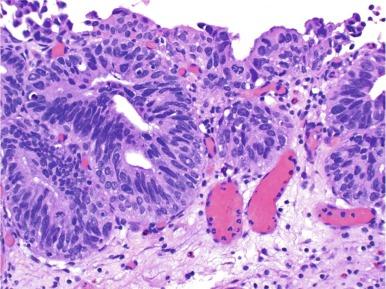
On rare occasions, urothelial carcinoma in situ may have a micropapillary architecture, characterized by a flat surface with micropapillae (pseudopapillae without vascular cores) lined by markedly atypical cells ( Fig. 6.23 ). This morphology is seen in the context of conventional urothelial carcinoma and seems to be unrelated to invasive micropapillary urothelial carcinoma.
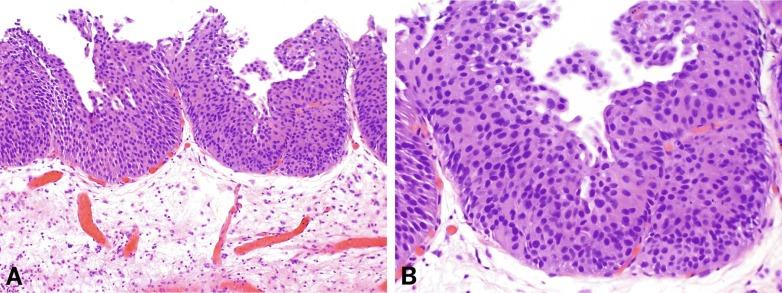
Carcinoma in situ with microinvasion was initially defined by Farrow and Utz as invasion into the lamina propria to a depth ≤ 5 mm from the basement membrane. At a recent consensus it was suggested that cases with more than 20 cells measured from the stroma-epithelial interface should be classified as fully invasive. Microinvasion appears as direct extension in cords (tentacular), single cells, or single cells and clusters of cells ( Fig. 6.24 ). The clusters of cells may have retraction artifact that mimics vascular invasion. Stromal response may be present, but in most cases it is absent. In cases with a prominent stromal inflammatory response the invasive neoplastic cells may be interspersed among lymphocytes, making them inconspicuous. In these circumstances, immunohistochemical staining with antibodies against CKs, such as AE1/AE3, highlights the invading cells.
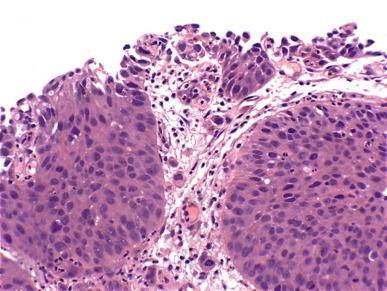
Bladder cancer is the seventh most common cancer worldwide, accounting for an estimated 330,380 new cases globally in 2012. There are significant variations in incidence, morbidity, recurrence, progression, and mortality rates of bladder cancer in different countries and ethnicity groups. African American men have a much lower incidence of bladder cancer, but their mortality rates are similar to Caucasians. Bladder cancer occurs two to five times more frequently in men than in women. This has been attributed to different smoking and occupational exposure between men and women.
Multiple risk factors have been linked to bladder cancer. Exogenous factors, such as tobacco smoking, occupational risk, and lifestyle exposure to carcinogens, all play important roles. Smokers have two to four times the risk for urothelial cancer as the general population, and heavy smokers have five times the risk. It is estimated that 20 years of smoking is needed for development of bladder cancer, and the probability of this event is directly correlated with the lifetime number of cigarettes consumed. The relative risk for active smokers experiencing development of bladder cancer compared with never smokers is 3:1 and for previous smokers is 1.9:1. Although the exact mechanism by which tobacco causes bladder cancer is not known, many known carcinogens in cigarette smoke, such as acrolein, 4-amino-biphenyl, arylamine, and oxygen free radicals, have been implicated. Furthermore, increased duration, intensity of tobacco consumption, and degree of inhalation significantly contribute to cancer development. The beneficial effects of smoking cessation, in contrast, include an almost immediate decline in risk for bladder cancer. Continued smokers have a worse recurrence-free survival than those who quit at the time of diagnosis. Ex-smokers and current smokers also have a significantly shorter recurrence-free survival after treatment for bladder cancer.
Occupational exposure to aniline dyes and aromatic amines such as 2-naphthylamine and benzidine is the second most prevalent risk factor for bladder cancer. Benzidine, the most carcinogenic aromatic amine, is used in dye production and as a hardener in the rubber industry. The degree of carcinogenesis caused by occupational exposure varies with the degree of industrialization, but in heavily industrialized nations, occupational exposure may account for up to one-fourth of all urothelial cancers. The latency period between exposure and tumor development is usually prolonged. Occupational bladder cancer has also been observed in gas workers, painters, and hairdressers. Nutrition may also play a role. Vitamin A supplementation apparently reduces the risk for bladder cancer, whereas fried food and fat ingestion increases the risk. A high fluid intake reduced the risk for bladder cancer in one study, but this remains controversial. Epidemiologic studies in Taiwan and Chile have shown an increased risk for urothelial cancer in people whose drinking water has a high content of arsenic. Other water contaminants with putative toxic effects on urothelium are also being actively investigated.
Additional factors implicated in the development and progression of bladder cancer include analgesic use, urinary tract infections (bacterial, parasitic, fungal, or viral), urinary lithiasis, pelvic radiation, and chemotherapeutic agents such as cyclophosphamide. Although caffeine ingestion has been implicated as a risk factor for bladder cancer, risk estimates for this association decrease after controlling for concomitant tobacco use. Similarly, saccharin-containing artificial sweeteners have induced bladder neoplasia in rats, but human epidemiologic studies have failed to establish this relationship in humans. There is a relationship between the parasite Bilharzia (schistosomiasis) and squamous cell cancer in the bladder, more frequently seen in the Middle East, where waterborne flatworms are endemic.
The majority of patients with bladder cancer present with hematuria. Approximately 20% of patients being evaluated for gross hematuria will subsequently be diagnosed with bladder cancer. Similarly, of patients presenting with microscopic hematuria, up to 10% will be diagnosed with bladder cancer. A significant proportion of patients also have irritative voiding symptoms including urgency, frequency, and dysuria; their symptoms are mistakenly attributed to urinary tract infection.
The initial evaluation and management for patients with suspected bladder cancer involve cystoscopic evaluation of the bladder and prostatic urethra for mucosal lesions. Small lesions and flat lesions worrisome for carcinoma in situ can be sampled with cold-cup biopsy forceps, whereas larger suspicious lesions are resected transurethrally as completely as possible. Transurethral resections and biopsies should include muscularis propria if possible. Tumor recurrence is a significant risk factor for cancer progression. New guidelines of the International Consultation on Urological Diseases were recently published. Advances in multiparametric magnetic resonance imaging are likely to change the clinical approach to bladder cancer diagnosis in years to come.
Development of multifocal tumors in the same patient, either synchronous or metachronous, is a common characteristic of urothelial malignancy ( Fig. 6.25 ). Multiple coexisting tumors have often arisen before clinical symptoms are apparent. The separate tumors may or may not share a similar histology. Two theories have been proposed to explain the frequency of urothelial tumor multifocality. The monoclonal theory suggests that the multiple tumors arise from a single transformed cell that proliferates and spreads throughout the urothelium either by intraluminal implantation or by intraepithelial migration. The field effect theory explains tumor multifocality as a development secondary to field cancerization effect. Chemical carcinogens cause independent transforming genetic alterations at different sites in the urothelial lining, leading to multiple genetically unrelated tumors.
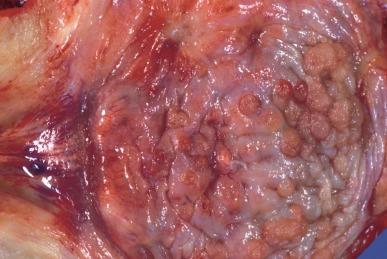
The issue of monoclonal versus oligoclonal origin of multifocal urothelial carcinomas is clinically important for understanding patterns of early tumor development when planning treatment and surgical strategies, and when molecular diagnostic techniques are used in the detection of recurrent or residual disease. The cause of multifocality also influences test design for genetic detection of recurrent or residual tumor cells in posttreatment urine samples. No consensus currently exists concerning which theory is most important in the development of multifocal urothelial carcinoma. Many studies have suggested a monoclonal origin for multifocal urothelial carcinoma, but other studies have shown an independent origin for some multicentric urothelial tumors using similar methods. A recent study suggests that both field cancerization and monoclonal tumor spread may coexist in the same patient. Molecular evidence supporting an oligoclonal origin for multifocal urothelial carcinomas in the majority of cases was found, consistent with the field cancerization theory for multicentric urothelial carcinogenesis.
Field cancerization, which is an important cause of multicentric squamous cell carcinomas of the head and neck, postulates that multifocal urothelial carcinomas arise in the same way. In the field cancerization process, simultaneous or sequential tumors result from numerous independent mutational events at different sites in the urothelial tract. These independent transformations are a consequence of external cancer-causing influences. In support of the field effect theory is the frequent finding of genetic instability in normal-appearing bladder mucosa in patients with bladder cancer in the adjacent urothelium. Premalignant changes, such as dysplasia or carcinoma in situ, often are found in urothelial mucosa away from an invasive bladder cancer ( Fig. 6.26 ). Many genetic comparisons and mapping of atypia in cystectomy specimens have emphasized the role of oligoclonality and field cancerization in the development of multifocal urothelial tumors, especially in early-stage disease. Because the monoclonal and oligoclonal theories to explain urothelial tumor multifocality are not mutually exclusive, various theories have been proposed to combine the two mechanisms. It has been suggested that oligoclonality is more common in early lesions with progression to higher stages leading to the overgrowth of one clone and pseudomonoclonality. Thus early or preneoplastic lesions may arise independently with a specific clone undergoing malignant transformation, which subsequently spreads through the urothelium by either an intraluminal or intraepithelial dissemination. Whereas tumor multifocality seems to be an oligoclonal phenomenon in the majority of cases, there is undeniable support for the monoclonal hypothesis in some cases.
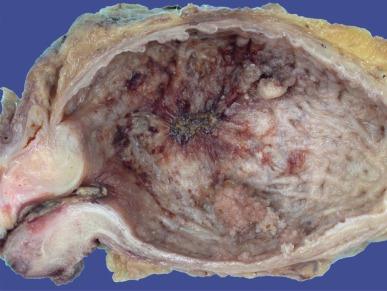
Recent studies have sought to better define the molecular characteristics of urothelial carcinoma using broad-based genomic and transcriptomic approaches to differentiate distinct molecular classes of urothelial carcinoma. Historically, a dual-pathway model was developed in which noninvasive lesions (low-grade papillary Ta) are associated with frequent HRAS and FGFR3 alterations, and frequent TP53 and RB alterations characterize high-grade urothelial carcinomas. The findings in more recent studies suggest that this model may somewhat oversimplify the genomic complexity of urothelial cancer. Based on complex gene expression studies, the number of bladder cancer subtypes has been reappraised. One group of investigators identified five categories of tumors that demonstrated differential expression of CK, FGFR3 mutational status, cell adhesion gene profiles, and cell-cycle regulator gene profiles. These five categories include the so-called urobasal A, urobasal B, genomically unstable, squamous cell carcinoma–like, and infiltrated. Three major subtypes—urobasal, genomically unstable, and squamous cell carcinoma–like—can also be distinguished based on immunohistochemical profile, enabling identification of such cases in daily pathology practice.
A simplified classification system was recently published that divides urothelial carcinoma into “luminal” and “basal-like” categories. Whereas luminal (CK20 + , GATA3 + ) carcinomas expressed genes frequently associated with superficial umbrella cells and appeared similar to superficial papillary tumors, basal-like (CK5/6 + , CD44 + , CK20 - ) carcinomas expressed genes more characteristic of urothelial basal cells and also had a significantly worse prognosis but may be more responsive to neoadjuvant chemotherapy. In addition to the luminal and basal-like tumors, some classification systems have identified a third group of tumors, “p53-like,” which are associated with resistance to neoadjuvant chemotherapy.
Immunotherapeutic strategies to target the programmed cell death-1/ programmed cell death-1 ligand (PD-1/PD-L1) axis represent a breakthrough in the treatment of bladder cancer. These agents act on T-cell–inhibitory pathways, unleashing profound antitumor effects. Drug options for patients with bladder cancer now include atezolizumab, pembrolizumab, nivolumab, durvalumab, and avelumab. The suggested cutoffs for evaluating available immunohistochemical markers associated with a specific drug are summarized in Table 6.5 .
| Characteristics | Durvalumab | Atezolizumab | Nivolumab | Pembrolizumab | Avelumab | |||
|---|---|---|---|---|---|---|---|---|
| Manufacturer | MedImmune/AstraZeneca | Genetech/Roche | Bristol-Meyers Squibb | Merck | Merck/Pfizer | |||
| Target | PD-L1 | PD-L1 | PD-1 | PD-1 | PD-L1 | |||
| PD-L1 assay | Ventana SP263 | Ventana SP142 | Dako 28-8 | Dako 22C3 | Dako 73-10 | |||
| Cell types scored for urothelial carcinoma | TIC and TC | TIC | TC | TC and TIC | TC | |||
| No. of lines of therapy | ≥ 1 | ≥ 2 | 1 (cisplatin ineligible) | ≥ 2 | ≥ 2 | 2 | 1 (cisplatin ineligible) | ≥ 2 |
| PD-L1 cutoffs | ||||||||
| High/positive | ≥ 25% TC or TIC | ≥ 5% TIC | ≥ 5% TIC | ≥ 1% TC | ≥ 1%, ≥ 5% TC | ≥ 10% CPS | ≥ 10% CPS | ≥ 5% TC |
| Low/negative | < 25% TC and TIC | < 1% TIC | < 1% TIC | < 1% TC | < 1% TC | Not available | < 10% CPS | No visible staining |
Histologic grading is one of the most important prognostic factors in bladder cancer. The first widely accepted grading system for papillary urothelial neoplasms was the 1973 WHO classification system, which divided urothelial tumors into four categories: papilloma, grade 1 carcinoma, grade 2 carcinoma, and grade 3 carcinoma. Histologic grading is based on the degree of cellular anaplasia, with grade 1 tumors having the least degree of anaplasia compatible with a diagnosis of malignancy, grade 3 tumors having the most severe degree of anaplasia, and grade 2 tumors having an intermediate degree of cellular anaplasia ( Fig. 6.27 ). Anaplasia is further defined by the authors of the 1973 WHO classification as increased cellularity, nuclear crowding, disturbed cellular polarity, failure of differentiation from the base to the surface, nuclear polymorphism, irregular cell size, variations in nuclear shape and chromatin pattern, displaced or abnormal mitotic figures, and giant cells.
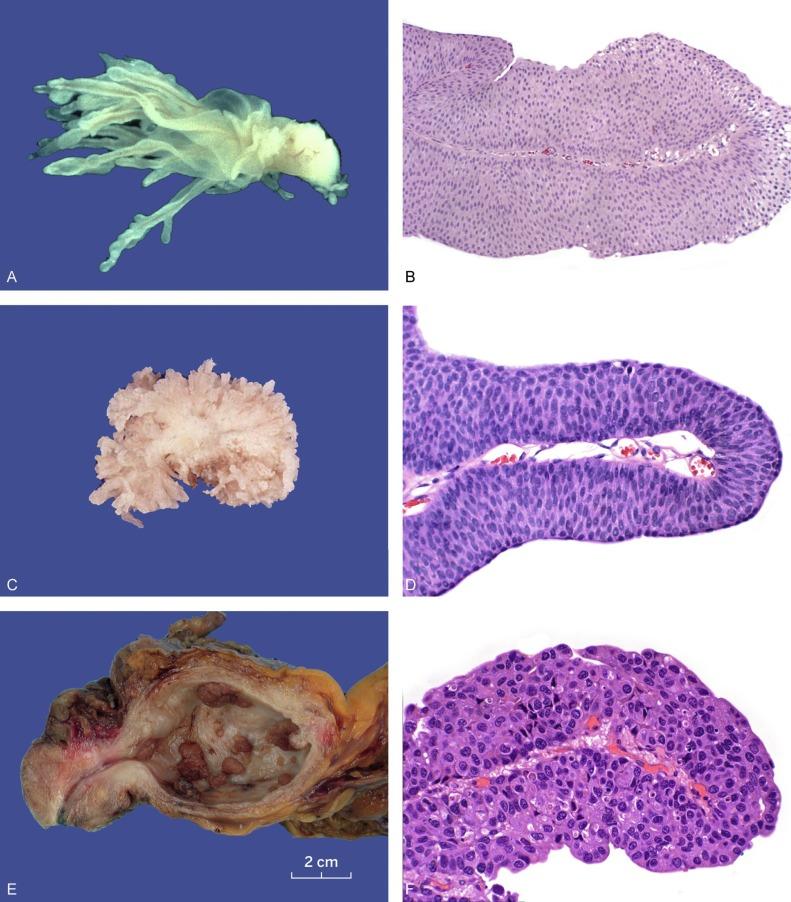
The 1973 WHO histologic grading of bladder cancer is one of most successful grading systems among all organ sites and has been validated since its introduction three decades ago. The 1973 WHO grading system has been accepted by pathologists, urologists, oncologists, and cancer registrars in the United States and elsewhere. An enormous amount of data have been accumulated using this system in studies of the morphologic properties, clinical behavior, treatment, and follow-up of urothelial tumors. Because of its relative simplicity and its well-documented powerful predictive value, it has been well accepted by urologists and used globally for several decades in making clinical decisions for management of patients with urothelial cancer.
A recent systematic review surveyed 3593 published articles and compared the prognostic performance and reproducibility of the 1973 WHO and 2004/2016 WHO grading systems. They found that higher tumor grade in both classifications was associated with higher disease progression and recurrence rates. Progression rates in grade 1 patients were similar to those in low-grade patients. However, the 1973 system identifies more aggressive tumors. Reproducibility of the 2004/2016 system was marginally better than that of the 1973 system. The authors could not confirm that the 2004/2016 classification outperforms the 1973 classification in prediction of recurrence and progression.
The European Association of Urology (EAU) guidelines on non–muscle-invasive urothelial carcinoma of the bladder recommend the use of both 1973 and 2004/2016 WHO classifications ( Table 6.6 ) (see further discussion later in this chapter).
| Risk Grouping | Criteria |
|---|---|
| Low-risk tumors | Primary, solitary, Ta, LG/G1, < 3 cm, no CIS |
| Intermediate-risk tumors | All tumors not defined in the two adjacent categories (between the category of low and high risk) |
| High-risk tumors | Any of the following:
|
Grade 1 papillary carcinoma consists of an orderly arrangement of normal urothelial cells lining delicate papillae with minimal architectural abnormality and minimal nuclear atypia ( Fig. 6.27 A and B). Nuclear grooves are usually present. There may be some complexity and fusion of the papillae, but this is usually not prominent. The urothelium is often thickened to more than seven cell layers. The urothelium displays normal maturation and cohesiveness, with an intact superficial cell layer. The nuclei tend to be uniform in shape and spacing, although there may be some enlargement and elongation. The chromatin texture is finely granular, without significant nucleolar enlargement. Mitotic figures are rare or absent, and basally located. Grade 1 tumor should be distinguished from urothelial papilloma, which is a benign lesion ( Table 6.7 ).
| Characteristics | Urothelial Papilloma | Grade 1 (Low-Grade) Urothelial Carcinoma |
|---|---|---|
| Age | Younger | Older |
| Sex (male:female) | 2:1 | 3:1 |
| Size | Small, usually < 2 cm | Typically, larger than papilloma |
| Microscopic findings | ||
| Well-formed papillae | Present | Present, rarely fused |
| Thickness of urothelium | ≤ 7 layers | > 7 layers |
| Superficial umbrella cells | Present | Usually present |
| Cytology | Minimal or absent | Mild |
| Nuclear enlargement | Rare or none | None or slightly enlarged |
| Nuclear hyperchromasia | Rare or none | Slight or minimal |
| Chromatin | Fine | Fine, slightly granular |
| Nucleolar enlargement | Absent | Absent or inconspicuous |
| Nuclear pleomorphism | Absent | Absent |
| Mitotic figures | None | Rare or basal location |
| Stromal invasion | Absent | Rare |
Grade 1 carcinoma appears to have a predilection for the ureteric orifices. In one study, 69% of grade 1 urothelial carcinomas were centered near a ureteric orifice, but the remainder was seen in all other portions of the bladder. Patients with grade 1 carcinoma are at increased risk for local recurrence, progression, and dying of bladder cancer. Significant levels of morbidity and mortality are associated with grade 1 urothelial carcinoma of the bladder if patients are followed for a sufficient interval. With 20 years of follow-up, Holmang et al. found that 14% of patients with noninvasive grade 1 urothelial carcinoma (pTa G1) died of bladder cancer. In a recent review of 152 patients with stage Ta grade 1 urothelial carcinoma, Leblanc et al. found that 83 patients (55%) had tumor recurrence, including 37% with cancer progression. Patients who remained tumor-free for 1 year still had a 43% chance of late recurrence. In Greene et al.’s study of 100 patients with grade 1 cancer, 10 patients (10%) died of bladder cancer after more than 15 years; of the 73 patients who had recurrences, 22% were of higher grade than the original tumor. The mean interval from diagnosis to the development of invasive cancer was 8 years. Jordan et al. studied 91 patients with grade 1 papillary urothelial tumors and found that 40% had recurrence. Twenty percent of patients with recurrences had high-grade (grade 3) cancer, and four patients (4%) died of bladder cancer. Long-term follow-up is recommended for patients with grade 1 papillary urothelial carcinoma.
Grade 2 carcinoma represents a broad group of tumors encompassing a spectrum of cytologic atypia and some variability in the relative proportions of cells with atypical features ( Fig. 6.27 C and D). Grade 2 carcinomas retain some of the orderly architectural appearance and maturation of grade 1 carcinoma but display at least focal moderate variation in orderliness, nuclear appearance, and chromatin texture, apparent at low magnification. Cytologic abnormalities are invariably present in grade 2 carcinoma, with moderate nuclear crowding, moderate loss of cell polarity, moderate nuclear hyperchromasia, moderate anisonucleosis, and mild nucleolar enlargement. Mitotic figures are usually limited to the lower half of the urothelium, but this is an inconstant feature. Superficial cells are usually present, and the urothelial cells are predominantly cohesive, although variation in cohesion may be present. Some tumors may be extremely orderly, reminiscent of grade 1 carcinoma, with only a small focus of obvious disorder or irregularity. These are considered grade 2 cancer, recognizing that tumor grade is based on the highest level of abnormality present.
The prognosis for patients with grade 2 urothelial carcinoma is significantly worse than for those with lower-grade papillary cancer. Recurrence risk for patients with noninvasive grade 2 cancer is 45% to 67%. Invasion occurs in up to 20%, and cancer-specific death is expected in 13% to 20% after surgical treatment. Patients with grade 2 cancer and lamina propria invasion are at even greater risk, with recurrences in 67% to 80% of cases, the development of muscle-invasive cancer in 21% to 49%, and cancer-specific death in 17% to 51% of those treated surgically. Some authors consider both nuclear pleomorphism and mitotic count as criteria for subdividing grade 2 urothelial cancer (grades 2A and 2B), and they have been successful in identifying groups of cancers with different outcomes. However, subclassification of grade 2 urothelial carcinoma is not recommended because of significant interobserver variability.
Grade 3 carcinoma displays the most extreme nuclear abnormality of any papillary urothelial cancer, similar to changes observed in urothelial carcinoma in situ ( Fig. 6.27 E and F). The obvious urothelial disorder and loss of polarity are present at scanning magnification. The superficial cell layer is partially or completely absent with grade 3 carcinoma, accompanied by prominent cellular discohesion. There is obvious loss of normal architecture, cell polarity, and frequent atypical mitotic figures. Cellular anaplasia, characteristic of grade 3 carcinoma, is defined as increased cellularity, nuclear crowding, random cellular polarity, absence of normal mucosal differentiation, nuclear pleomorphism, irregularity in cell size, variation in nuclear shape, capricious chromatin pattern, increased frequency of mitotic figures, and occasional neoplastic giant cells.
Recurrence risk for patients with noninvasive grade 3 cancer is 65% to 85%, with invasion occurring in 20% to 52% and cancer-specific death in up to 35% after surgical treatment. Of surgically treated patients with grade 3 cancer and lamina propria invasion, 46% to 71% experience recurrences, 24% to 48% have muscle-invasive cancer, and 25% to 71% suffer cancer-specific death, emphasizing the need for aggressive treatment of these patients.
The first widely accepted grading system for papillary urothelial neoplasms was the 1973 WHO classification system. In 1998 a revised system of classifying noninvasive papillary urothelial neoplasms of the urinary bladder was proposed by the ISUP ( Table 6.8 ). This system was formally adopted by the WHO in 1999 and was published in Pathology and Genetics of Tumors of the Urinary System and Male Genital Organs (3rd and 4th editions), which is part of a series of WHO “Blue Books” for the classification of tumors. This system separates noninvasive papillary urothelial neoplasms into four categories, designated papilloma, PUNLMP, low-grade carcinoma, and high-grade carcinoma ( Fig. 6.28 ; Table 6.8 ).
| 1973 WHO | 1998 WHO/ISUP | 1999 WHO | 2016 WHO | Current Proposal |
|---|---|---|---|---|
| Papilloma | Papilloma | Papilloma | Papilloma | Papilloma |
| Grade 1 | PUNLMP | PUNLMP | PUNLMP | Grade 1 (low grade) |
| Grade 2 | Low grade | Grade 1 | Low grade | Grade 2 (low grade) |
| Grade 2 | Grade 3 (high grade) | |||
| Grade 3 | High grade | Grade 3 | High grade | Grade 4 (high grade) |
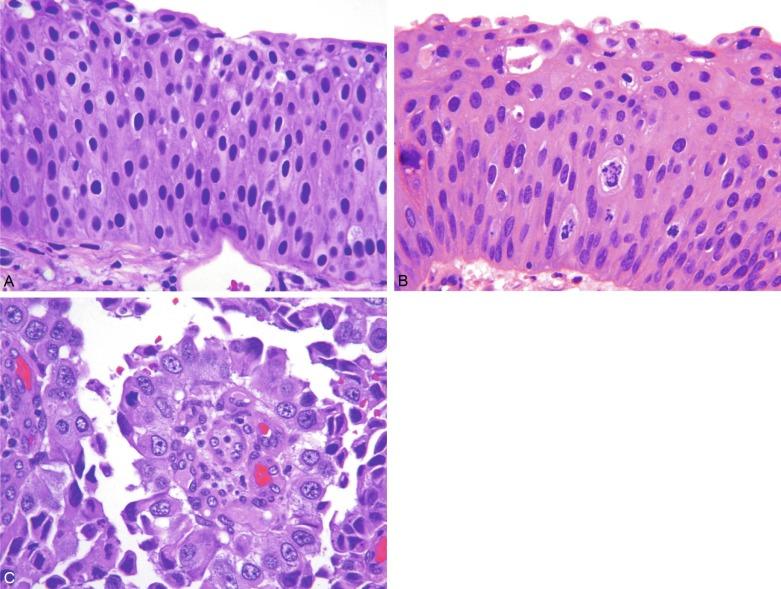
A PUNLMP is a low-grade urothelial tumor with a papillary architecture and a purported low incidence of recurrence and progression. This lesion is histologically defined by the 2004/2016 WHO classification system as a papillary urothelial tumor, which resembles the exophytic urothelial papilloma but with increased cellular proliferation exceeding the thickness of normal urothelium ( Fig. 6.28 A). All such tumors would have been considered grade 1 urothelial carcinomas by the 1973 WHO grading system. Cytologic atypia is minimal or absent, and architectural abnormalities are minimal with preserved polarity. Mitotic figures are infrequent and usually limited to the basal layer. Clinically, these tumors show a male predominance (3:1) and occur at a mean age of 65 years. They are most commonly identified during investigation of gross or microscopic hematuria. Cystoscopically, these lesions are typically 1 to 2 cm in greatest dimension and located on the lateral wall of the bladder or near the ureteric orifices. They have been described as having a “seaweed in the ocean” appearance.
Several studies have shown that the 2004 WHO classification can differentiate noninvasive papillary urothelial tumors into prognostic groups. When applied to transurethral resection of bladder tumor specimens, this classification system predicted the pathologic stage in the corresponding cystectomy. However, the published recurrence and progression rates are variable. A recent meta-analysis suggests that both 1973 and 2004 WHO grading systems predict progression and recurrence. They also conclude that the 1973 WHO grading system identifies more aggressive tumors. These results may argue in favor of reporting both grading systems in daily practice.
In a series of 112 patients diagnosed with PUNLMP, with up to 35 years of follow-up (median, > 12 years), tumor recurrence was observed in 29% of patients. Seventy-five percent of patients with tumor recurrence had a higher tumor grade (i.e., low-grade or high-grade urothelial carcinoma according to the 2004/2016 WHO classification). The overall disease progression rate in these patients with PUNLMP was 4%. With a median follow-up of 56 months, the 1973 WHO grade 1 tumors had a progression rate of 11%, whereas the 2004/2016 WHO PUNLMP tumors had a progression rate of 8%. The tumor recurrence rate after PUNLMP resection was reported to be 35% in the study by Holmang et al. and 47% in the study by Pich et al. These authors concluded that PUNLMP and low-grade carcinoma have similar risks for progression. More recently Pan et al. showed recurrence and progression rates were 18% and 2%, respectively, for PUNLMP. Also, in a study of 53 PUNLMP tumors with a mean follow-up period of 11.7 years, Fujii et al. reported a recurrence rate of 60%, with 34% progressing to low-grade carcinoma and 8% progressing to invasive carcinoma (stage T1). Taken together, these data indicate that patients with PUNLMP do not have a benign neoplasm, but instead have a significant risk for tumor recurrence and disease progression. PUNLMP is not substantially different from noninvasive Ta grade 1 carcinoma as defined by 1973 WHO criteria; long-term clinical follow-up is recommended for these patients. A recent study reported that TERT promoter mutations are present in 43% of PUNLMP cases.
Despite provision of detailed histologic criteria for the diagnostic categories in the 2004/2016 WHO system, improvement in intraobserver and interobserver variability compared with the 1973 WHO system was limited. In fact, Mikuz demonstrated that interobserver agreement was higher using the 1973 WHO classification than when using either the 2004/2016 WHO or 1999 WHO/ISUP systems. In a study by Yorukoglu et al. the intraobserver and interobserver reproducibility of both the 2004/2016 WHO and the 1973 WHO systems were evaluated by assigning six urologic pathologists to the task of independently reviewing 30 slides of noninvasive papillary urothelial tumors in a study set. They found no statistical difference between the reproducibility achieved with either system; the new system failed to improve reproducibility. There was agreement for PUNLMP in only 48% of cases, and reproducibility was lower for low-grade tumors in both the 2004/2016 WHO and the 1973 WHO systems. Murphy et al. recorded a 50% discrepancy rate among pathologists attempting to distinguish between PUNLMP and low-grade papillary urothelial carcinoma after a period of structured pathologist education.
A low-grade papillary urothelial carcinoma shows fronds with recognizable variation in architecture and cytology. The tumor shows slender papillae with frequent branching and variation in nuclear polarity; nuclei show enlargement and irregularity; chromatin is vesicular, and nucleoli are often present ( Fig. 6.28 B). Mitotic figures may occur at any level in low-grade papillary urothelial carcinoma. Such cases would have been considered as grade 1 or 2 in the 1973 WHO classification scheme. Altered expression of CK20, CD44, p53, and p63 is frequent. Some tumors are diploid, but many are aneuploidy. FGFR3 mutations are seen with about the same frequency as in PUNLMP. The male-to-female ratio is 2.9:1, and the mean age is 70 years (range, 28 to 90 years). Most patients present with hematuria and have a single tumor in the posterior or lateral bladder wall. However, 22% of patients with low-grade papillary urothelial carcinoma have two or more tumors. Tumor recurrence, stage progression, and tumor-related mortality rates are 50%, 10%, and 5%, respectively. Stage progression may be as high as 13% as reported in one series.
Pellucchi et al. were able to further stratify 2004/2016 WHO low-grade urothelial carcinomas into two separate risk groups using the 1973 WHO grading scheme. According to the 1973 WHO grading system, 87 low-grade (2004/2016 WHO) tumors (32%) were classified as 1973 WHO grade 1 tumors, and 183 low-grade (2004/2016 WHO) tumors (68%) were classified as 1973 WHO grade 2 tumors among 270 consecutive patients with a first episode of low-grade pTa bladder cancer at transurethral resection of the bladder between 2004/2016 and 2008. Five-year recurrence-free survival rate was 49% for the low-grade population and 62% and 40% for the 1973 WHO grade 1 and 2 groups, respectively. In a recent analysis of 348 patients the authors found that the 1973 WHO grading system is more suitable than the 2004/2016 WHO grading system for predicting prognosis in non–muscle-invasive bladder cancer.
Low-grade invasive urothelial carcinomas have been reported recently. In a series of 23 cases, 5 (23%) experienced high-grade invasive urothelial carcinoma and 2 experienced metastatic disesae.
In high-grade papillary urothelial carcinoma the cells lining papillary fronds show obvious disordered arrangement with cytologic atypia ( Fig. 6.28 C). All tumors classified as grade 3 in the 1973 WHO scheme, as well as some tumors assigned grade 2 in that classification, would be considered high-grade carcinomas in the 2004/2016 WHO classification. The papillae are frequently fused. Both architectural and cytologic abnormalities are recognizable at scanning power. The nuclei are pleomorphic with prominent nucleoli and altered polarity. Mitotic figures are frequent. The thickness of the urothelium varies considerably. Carcinoma in situ is frequently evident in the adjacent mucosa. Changes in CK20, p53, and p63 expression, as well as aneuploidy, are more frequent than in low-grade lesions. Molecular alterations in these tumors include overexpression of p53, HER2, or EGFR and loss of p21Waf1 or p27kip1 as seen with invasive cancers. Genetically, high-grade noninvasive lesions (pTa G3) resemble invasive tumors. A comparative genomic hybridization-based study showed deletions at 2q, 5q, 10q, and 18q, as well as gains at 5p and 20q. Hematuria is common, and the endoscopic appearance varies from papillary to nodular or solid. There may be single or multiple tumors. Stage progression and death due to disease are observed in as many as 65% of patients. In a recent analysis of 85 patients with Ta high-grade urothelial carcinoma, recurrence and tumor progression rates were 37% and 40%, respectively.
A four-tier grading categorization of urothelial carcinomas was proposed in 2012. In this system noninvasive papillary urothelial carcinomas are separated into four categories: grade 1 urothelial carcinoma (low grade), grade 2 urothelial carcinoma (low grade), grade 3 urothelial carcinoma (high grade), and grade 4 urothelial carcinoma (high grade) ( Table 6.9 ; Figs. 6.29 and 6.30 ). PUNLMP is classified as “grade 1 urothelial carcinoma (low grade)” in the four-tier grading scheme. Urothelial papilloma remains as a benign urothelial tumor following identical diagnostic criteria and terminology to those defined in the 1973 and 2004/2016 WHO classifications.
| Features | Grade 1 (Low Grade) |
Grade 2 (Low Grade) |
Grade 3 (High Grade) |
Grade 4 (High Grade) |
|---|---|---|---|---|
| Increased cell layers (> 7) | Yes | Variable | Variable | Variable, usually < 7 layers |
| Superficial umbrella cells | Present | Often present | Usually absent | Usually absent |
| Polarity/overall architecture | Normal | Mildly distorted | Moderately distorted | Severely distorted |
| Discohesiveness | Normal | Normal | Mild to moderate | Severe |
| Clear cytoplasm | May be present | May be present | Usually absent | Usually absent |
| Nuclear size | Normal or slightly increased | Mildly increased | Moderately increased | Markedly increased |
| Nuclear pleomorphism | Uniform, slightly elongated to oval | Mild, round to oval with slight variation in shape and contour | Moderate | Marked |
| Nuclear polarization | Normal to slightly abnormal | Abnormal | Abnormal | Absent |
| Nuclear hyperchromasia | Slight or minimal | Mild | Moderate | Severe |
| Nuclear grooves | Present | Present | Absent | Absent |
| Nucleoli | Absent or inconspicuous | Inconspicuous | Enlarged, often prominent | Multiple prominent nucleoli |
| Mitotic figures | None/rare, basal location | May be present, at any level | Often present | Prominent and frequent, atypical forms |
| Stromal invasion | Rare | Uncommon | May be present | Often present |
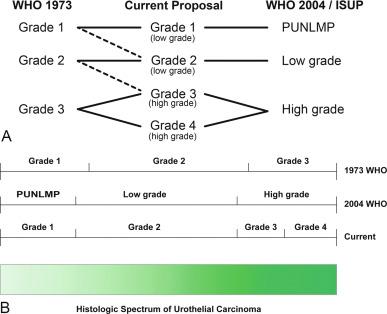
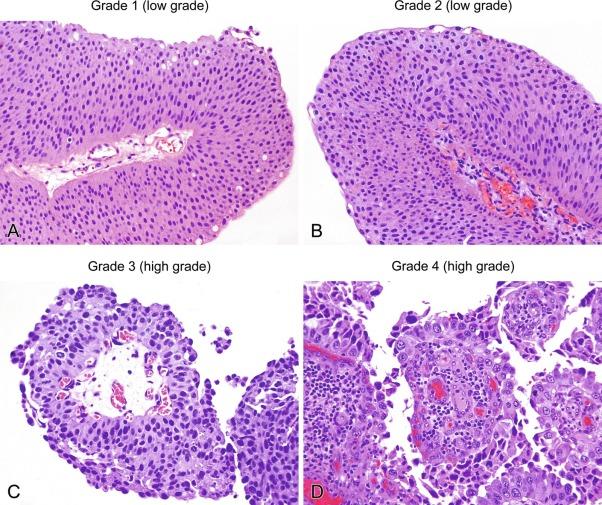
The diagnostic criteria are identical to those defined in the 1998 WHO/ISUP and 2004/2016 WHO classifications for PUNLMP ( Fig. 6.30 A). We propose to change the terminology of PUNLMP to “grade 1 urothelial carcinoma (low grade).” In these tumors, cytologic atypia is minimal or absent, and architectural abnormalities are slight with preserved polarity. Mitotic figures are infrequent and usually limited to the basal layer. Grade 1 tumor should be distinguished from urothelial papilloma, which is a benign lesion without invasive potential or risk for progression. The key difference between papilloma and grade 1 urothelial carcinoma (low grade) is the number of epithelial layers covering the papillae ( Table 6.9 ).
The diagnostic criteria are identical to those defined in the 1998 WHO/ISUP and 2004/2016 WHO classifications for low-grade urothelial carcinomas ( Fig. 6.30 B). These tumors are characterized by an overall orderly appearance, but with areas of variation in architectural and cytologic features recognizable at scanning power ( Table 6.9 ). They are differentiated from grade 1 urothelial carcinoma (low grade) by the presence of easily recognizable cytologic atypia including variation of polarity and nuclear size, shape, and chromatin texture. Mitotic figures are infrequent and may be seen at any level of the urothelium.
Grade 3 urothelial carcinomas (high grade) display an intermediate degree of architectural and cytologic abnormality between grade 2 urothelial carcinomas (low grade) and grade 4 urothelial carcinomas (high grade) ( Fig. 6.30 C). Architectural disorder in these tumors is obvious, with branching and bridging of papillary projections. Nevertheless, a certain degree of polarity and nuclear uniformity are still discernible. Severe anaplasia is not seen in these tumors. All grade 3 urothelial carcinomas would be classified as high-grade urothelial carcinoma using the 2004/2016 WHO classification scheme.
Cases with severe nuclear anaplasia are considered grade 4 urothelial carcinoma in the current proposal. These tumors present an overall impression of complete architectural disorder with absence of polarity, loss of superficial umbrella cells, and marked variation of all nuclear parameters ( Table 6.9 ). Numerous irregularly distributed mitotic figures are frequently noted. Severe cytologic atypia is usually uniformly present in all fields or all histologic sections examined ( Fig. 6.30 D). Unlike grade 1 or grade 2 urothelial carcinoma (low grade), these tumors often have less than seven layers in thickness. Cellular discohesiveness is remarkable. These cases are typically associated with stromal invasion and advanced stage bladder cancer.
Unusually aggressive variants of urothelial carcinoma, including nested variant, micropapillary variant, plasmacytoid variant, sarcomatoid carcinoma, small cell carcinoma, undifferentiated carcinoma, and giant cell carcinoma, should also be graded as grade 4 tumors.
To improve understanding and to standardize use of the 1973 WHO classification, an expanded and refined contemporary description of the scheme was presented in 2001. This proposal is known as the Ancona refinement of the 1973 WHO grading system. This effort was inspired by discussions during the international consensus meeting on bladder cancer held in Ancona, Italy, in 2001. It was proposed that urothelial tumors be divided into two main groups based on growth pattern: flat and papillary. Flat tumors form a morphologic continuum whose classification includes reactive changes, dysplasia, and carcinoma in situ (see previous discussion). Papillary tumors include papilloma, grade 1 papillary carcinoma, grade 2 papillary carcinoma, and grade 3 papillary carcinoma. The diagnostic criteria for each of these categories were refined and optimized for reproducibility. The use of terms that had been recently introduced for new urothelial neoplasia grading schemes, including low malignant potential and atypia of uncertain clinical significance , was discouraged. Grading of bladder cancer should be based on the highest level of abnormality noted. No formal recommendation has been previously made regarding the amount or extent of a higher grade needed for upgrading, but the Ancona refinement requires at least one high-power field (40 × objective magnification with 20 × ocular magnification).
The publication of the 1999 WHO blue book introduced a grading scheme. This new classification retained the three-tiered numbering system (grade 1, grade 2, and grade 3 carcinomas). However, tumors formerly classified as 1973 WHO grade 1 were subdivided into PUNLMP and grade 1 tumors ( Table 6.8 ). In the 1999 WHO classification, which differed from the 1998 WHO/ISUP and 1973 WHO classifications, papillary tumors of the urinary bladder were subclassified as papilloma, PUNLMP, grade 1, grade 2, and grade 3. The definition of papilloma remains the same in all new grading systems and is defined as a papillary tumor with a delicate fibrovascular stroma lined by cytologically and architecturally normal urothelium without increased cellularity or mitotic figures.
Papillary urothelial neoplasms encompass a spectrum of morphologic findings including tumors that behave aggressively and tumors that are biologically benign. Attempting to differentiate biologic behavior based solely on subtle histopathologic criteria is fraught with difficulties and perils, especially considering the significant interobserver variability that has been documented in numerous studies with all classification schemes. The 2004/2016 WHO/ISUP system provides clearly defined histologic criteria for each of its diagnostic categories; however, urothelial neoplasms frequently demonstrate features of more than one grade ( Fig. 6.31 ). The grading of papillary urothelial tumors is typically based on the worst grade present. However, cancer heterogeneity could have a significant impact on patient outcome. Cheng et al. examined 164 patients with stage Ta urothelial tumors and found that approximately one-third of tumors had morphologic tumor heterogeneity consistent with more than one histologic grade. They graded both the primary and secondary patterns of tumor growth by the 2004/2016 WHO/ISUP criteria with PUNLMP, low-grade carcinoma, and high-grade carcinoma patterns receiving scores of 1, 2, and 3, respectively. Each tumor was then evaluated by a combined scoring system on a scale of 2 to 6. With a median follow-up of 9.2 years, the prognosis of patients with a combined score of 6 (the entire tumor consisting of high-grade carcinoma) is considerably worse than those with a combined score of 5 (a tumor consisting of low- and high-grade carcinoma) (26% versus 68% 10-year progression-free survival; P = 0.02). The significant survival difference (42%) between score 5 and score 6 groups may suffice to warrant different management strategies in appropriate settings. Subsequent studies have also suggested that combined scoring systems may be useful in the grading of bladder tumors. Grading should take cancer heterogeneity into consideration, because prognostic accuracy was increased when the combined primary and secondary grades were applied. This finding (two-numbered grading system) was recently validated.
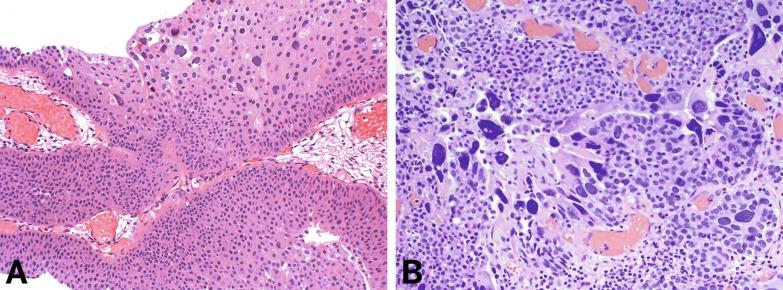
Neither the 2004/2016 WHO/ISUP system nor the 1973 WHO system takes tumor heterogeneity into account; however, the 1973 WHO system does allow a greater amount of diagnostic flexibility in that tumors are frequently classified as grade 1 to 2 or grade 2 to 3. This added flexibility may give a more accurate representation of the tumor histology than attempting to force a lesion into a single diagnostic category. It appears that prognostic accuracy is improved when heterogeneity is considered. Future investigations are needed to fully address the impact of tumor heterogeneity on clinical outcome.
At gross examination, most tumors present as a single, solid, polypoid mass with or without ulceration, and may also appear sessile and extensively infiltrate the bladder wall ( Fig. 6.32 ). Histologically, the neoplastic cells invade the bladder wall as nests, cords, trabeculae, small clusters, or single cells that are often separated by a desmoplastic stroma. The tumor sometimes grows in a more diffuse, sheetlike pattern, but even in these cases, focal nests and clusters are generally present. The cells show moderate to abundant amphophilic or eosinophilic cytoplasm and large hyperchromatic nuclei. In larger nests, palisading of nuclei may be seen at the edges of the nests. The nuclei are typically pleomorphic and have irregular contours with angular profiles. Nuclear grooves may be identified in some cells. Nucleoli are highly variable in number and appearance. Some cells contain single or multiple small nucleoli, and others have large eosinophilic nucleoli. Foci of marked pleomorphism may be seen, with bizarre and multinuclear tumor cells present. Mitotic figures are common, including many abnormal forms. Invasive tumors are most commonly high grade, usually showing marked anaplasia with focal giant cell formation.

Pathologic stage is most critical for assessing patient prognosis. The 2017 TNM (tumor, lymph node, and metastasis) staging information should be provided in the pathology report ( Figs. 6.33 and 6.34 ; Table 6.10 ).
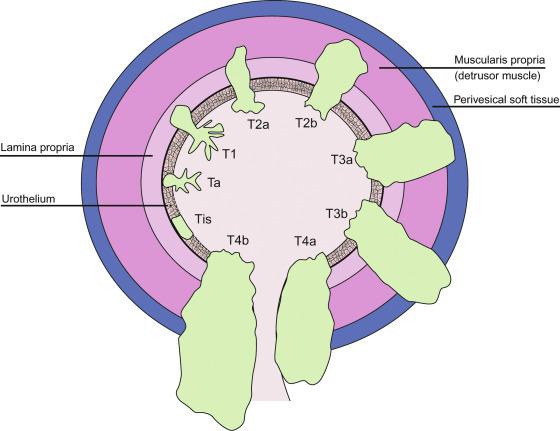
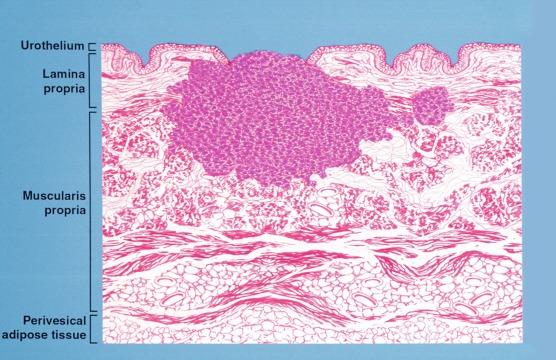
| Primary tumor (T) a | |
| TX | Primary tumor cannot be assessed |
| T0 | No evidence of primary tumor |
| Ta | Noninvasive papillary carcinoma |
| Tis | Carcinoma in situ |
| T1 | Tumor invades subepithelial connective tissue (lamina propria) |
| T2 | Tumor invades muscularis propria |
| T2a | Tumor invades superficial muscularis propria (inner half) |
| T2b | Tumor invades deep muscularis propria (outer half) |
| T3 | Tumor invades perivesical tissue |
| T3a | Microscopically |
| T3b | Macroscopically (extravesical mass) |
| T4 | Tumor invades any of the following: prostatic stroma, uterus, vagina, pelvic wall, and abdominal wall |
| T4a | Tumor invades prostatic stroma* or uterus or vagina |
| T4b | Tumor invades pelvic wall or abdominal wall |
| *Subepithelial invasion of prostatic urethra does not constitute T4 staging status. | |
| The suffix “m” should be added to the appropriate T category to indicate multiple tumors. The suffix “is” may be added to any T to indicate the presence of associated carcinoma in situ. | |
| Regional lymph nodes (N) | |
| NX | Regional lymph nodes cannot be assessed |
| N0 | No regional lymph node metastasis |
| N1 | Single regional lymph node metastasis in the true pelvis (perivesical, obturator, internal and external iliac, or sacral lymph node) |
| N2 | Multiple regional lymph node metastasis in the true pelvis (perivesical, obturator, internal and external iliac, or sacral lymph node) |
| N3 | Lymph node metastasis to the common iliac lymph nodes |
| Distant metastasis (M) | |
| M0 | No distant metastasis |
| M1 | Distant metastasis |
| M1a | Distant metastasis limited to lymph nodes beyond the common illiacs |
| M1b | Non–lymph node distant metastases |
a TNM descriptors: For identification of special cases of TNM or pTNM classifications, the “m” suffix and “y” and “r” prefixes are used. The “m” suffix indicates the presence of multiple primary tumors in a single site and is recorded in parentheses: pT(m)NM. The “y” prefix indicates those cases in which classification is performed during or after initial multimodality therapy. The “r” prefix indicates a recurrent tumor when staged after a documented disease-free interval and is identified by the “r” prefix: rTNM.
Infiltrating urothelial carcinoma is defined by the WHO as a urothelial tumor that invades beyond the basement membrane. The 2017 TNM staging system defines pT1 tumors of the bladder as those invading the lamina propria, but not the muscularis propria. The recognition of lamina propria invasion by urothelial carcinoma is one of the most challenging fields in surgical pathology, and the pathologist should follow strict criteria in its assessment ( Table 6.11 ; Fig. 6.35 ).
Become a Clinical Tree membership for Full access and enjoy Unlimited articles
If you are a member. Log in here